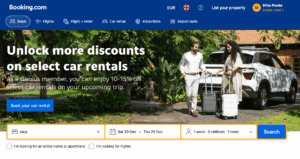It’s impossible to overstate the power of a great domain name for a business. Get it right, and an endless flow of online traffic could be yours, as domain name expert Joe Uddeme explains.
The Internet evolves and is shaped by countless businesses, people, non-profits and an array of other entities looking for eyeballs in an ever-changing world.
Buying a premium domain name is crucial in today’s clutter. Brands work hard to engrain their product or service in the public psyche and establish market positioning and relevance. Your domain name is part of the deal.
Savvy brands understand the importance of creating something catchy and memorable. They need to separate themselves from their competition in ways that remain top-of-mind for their targeted audience.
In this post, we’ll look at some of the reasons why companies large and small spend so much time and money acquiring a valuable premium name. And why you should, too.
Key takeaways
- Proof that top brands have instantly recognizable domain names
- How a great domain name helps leverage your position in any marketplace
- Questions to ask when searching for a valuable premium domain name
What’s in a name?
Let’s start by looking at the top ten brands, according to Wikipedia:
| Rnk |
Company |
Rev($B) |
FY |
Employees |
Mkt. Cap |
Location |
Founded |
|
| 1 |
Amazon |
$232.9 |
2018 |
647,500 |
$802.3 |
Seattle |
1994 |
[1][2] |
| 2 |
Alphabet Inc. |
$136.8 |
2018 |
98,771 |
$791.01 |
Mountain View, CA |
1998 |
[3][4] |
| 3 |
JD.com |
$55.7 |
2017 |
137,975 |
$34.84 |
Beijing |
1998 |
[5][6] |
| 4 |
Facebook |
$55.01 |
2018 |
25,105 |
$486.39 |
Menlo Park, CA |
2004 |
[7][8] |
| 5 |
Alibaba |
$39.90 |
2018 |
66,421 |
$432.12 |
Hangzhou |
1999 |
[9][10] |
| 6 |
Tencent |
$36.39 |
2017 |
44,796 |
$434.66 |
Shenzhen |
1998 |
[11][12] |
| 7 |
Netflix |
$15.8 |
2018 |
5,400 |
$153.39 |
Los Gatos, CA |
1997 |
[13][14] |
| 8 |
Booking |
$12.7 |
2017 |
22,900 |
$92.94 |
Norwalk, CT |
1996 |
[15] |
| 9 |
Baidu |
$12.40 |
2016 |
45,887 |
$88.11 |
Beijing |
2000 |
[16][17] |
| 10 |
eBay |
$10.75 |
2018 |
14,000 |
$32.07 |
San Jose |
1995 |
[18][19] |
Each of these companies went out and acquired their core premium domain name – no matter what the cost. They also understood the value of having .com as their global brand. Let’s dig a bit deeper into the strategy of one of the major power-houses listed above.
Facebook.com also owns many other valuable pieces of digital, beach-front real estate. Take for example, FB.com which complements the existing digital strategy that was already in place. Facebook has parlayed their web presence by building another piece of digital real estate alongside their own majestic piece of real estate.
Another example is Booking.com, with more than $12 billion in revenues. They do a phenomenal job of attracting users with constant ad-driven messaging. They have partnerships with more than 660,000 hotels and provide a valuable service to their clientele.

Why Premium Domains?
Let’s continue with the beach-front real estate analogy. For the past thirty years, brands have been swallowing up the short, brandable .com domains. These are the assets that provide the most upside, equity and long-term value to the brands. These assets can hold generic value, such as Booking.com, or be more brandable, such as ebay.com or Baidu – to name a few.
Premium domain names have commercial appeal and are typically very memorable. Brands spend huge amounts of money attracting new users and creating brand credibility. Digital strategists – including speculators who buy and sell domains for profit – are competing for a smaller piece of the available premium domain name inventory.
Having a great domain name is only half the battle. Success lies in how you develop the brand and create long-term equity for your company. For this reason, companies should always acquire the shortest variation for their brand (Tesla, for example, spent an undisclosed amount on tesla.com so they no longer had to be teslamotors.com).
This doesn’t have to be the only strategy. Companies should outline a comprehensive domain name strategy that not only covers their brand but any additional reputation management/brand defense needed to protect their corporate brand positioning.
Simply put, premium domain names come with the following instant upside:
- Brand-dominance and positioning
- Equity toward a long-term exit strategy
- Inability to build against – a defensive strategy against your competition
Own the real estate before your competitors do!
Most successful brands have identified the importance of the premium domain name. They have dedicated digital strategists or digital departments to handle the larger need for digital integration and social media components.
Brands should spend wisely and methodically when securing a new brand or piece of beach-front digital real estate.
Get it right the first time with help from a broker
Domain name brokerage services like NameExperts help businesses with their domain strategy and are in high demand. Whether or not they work with us, we always advise companies to use the following checklist to make sure they are not leaving money on the table:
- Conduct Research—who owns the asset and for how long have they had it? Is it being used? Are there active trademarks? What’s the history of the link profile?
- Variations and Alternatives—brands need to nail it. To do this, sometimes, they need to think outside the box. Find viable alternative assets that define your image and brand.
- Negotiation is key—do you negotiate for a living? We do. We remove the emotional attachment and red tape to manage both buyers’ and sellers’ expectations.
- Be Flexible—sometimes you have to give a little to get a little. Don’t be afraid to be flexible and offer ways to benefit the other party in your transaction.
- Be Honest—honesty and integrity go a long way. Be true to your word and don’t go back on what you say. This is critical for deals to succeed.
- Ask Questions—hold your broker or expert accountable and ask appropriate questions. Some domain transactions move quickly. A clear line of communication is necessary to save valuable money and time.
- Due Diligence—dig for more information and market comparisons: it’s all firepower necessary to make the case.
- Timing—don’t hunt for a CBD-themed/Marijuana-type name when there is mass decriminalization and legalization occurring. The market is just too hot, and pricing will be inflated. Instead, names should be selected “ahead-of-the-curve”.

Don’t fall at the first hurdle
When buying a premium domain name, it’s important to ask the right questions – it can save the buyer tons of money in the long-run. A common issue relates to trademarks tied to a name/brand. Many companies secure a domain name for commercial use but never take the time to search the trademark database. This quick search can save clients thousands of dollars.
Premium domain names make total sense for any emerging brand looking to scale their brand – and shortening the global domain name is still the foundation for successful growth. The top companies around the world continue to focus on the universally popular .com for brand growth.
This validates the need for a superb, premium domain name for your company and brand. Get it right the first time and save money in the long run – while adding credibility and equity value while you’re doing it.
About the author
Joe Uddeme is Director and Principal of Name Experts, one of the world’s leading domain name brokerage services. He has overseen domain name sales and acquisitions totaling more than $150 million and is renowned worldwide as a go-to expert in buying and selling premium domains. Contact us at: [email protected]












